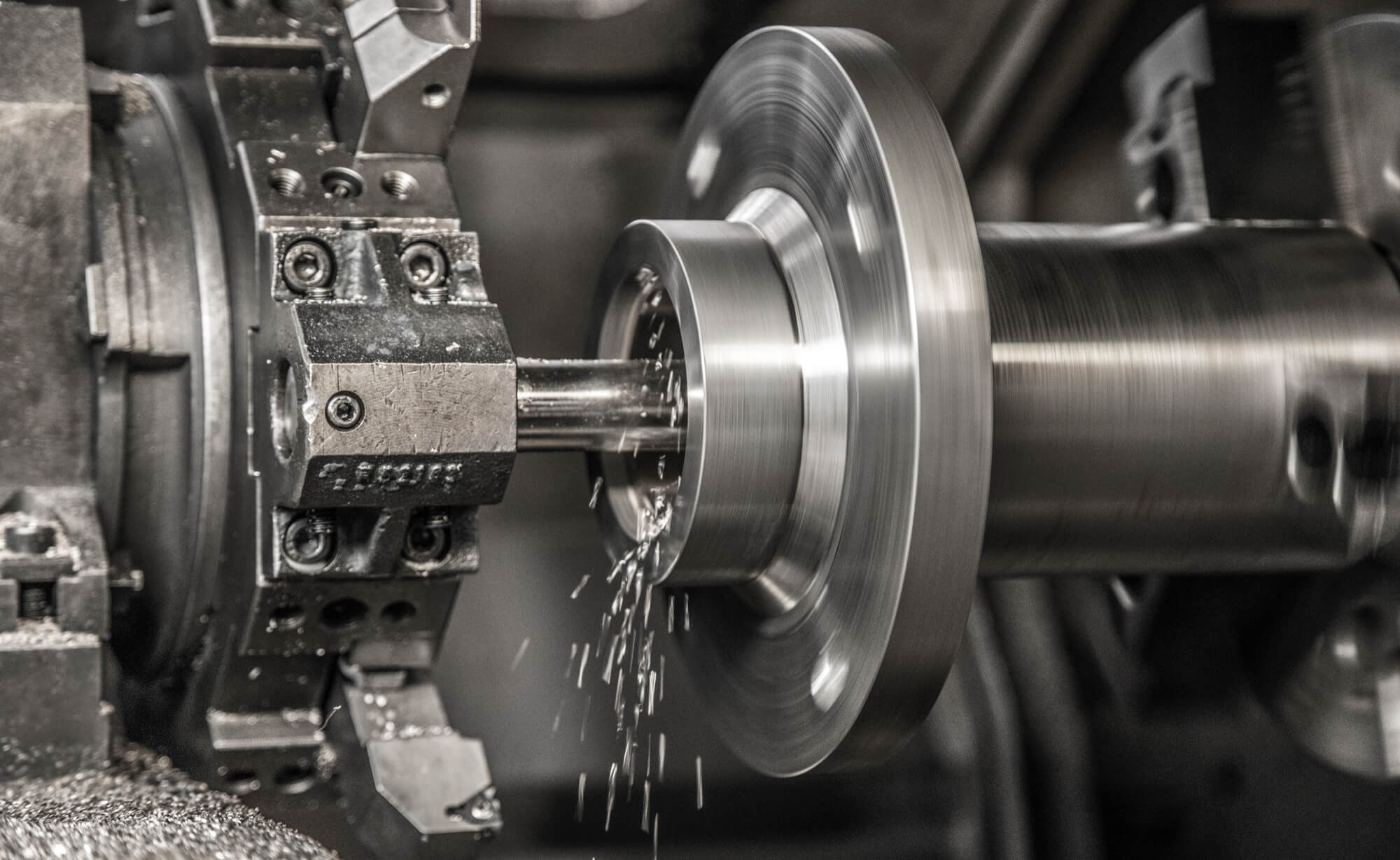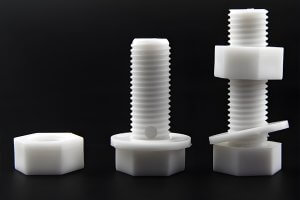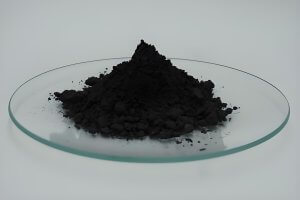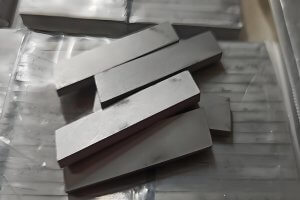The reaming process for stainless steel parts involves the following steps:
Tool Geometry Design
- Most reaming of stainless steel materials uses carbide reamers. The structure and geometric parameters of these reamers differ from standard reamers. To enhance the strength of the cutting teeth and prevent chip clogging during reaming, the number of teeth on the reamer is generally fewer.
- Front Angle: Typically 8° to 12°, but for high-speed reaming, it can be 0° to 5°.
- Back Angle: Generally 8° to 12°.
- Main Inclination Angle: Varies depending on the hole type. For through holes, it is usually 15° to 30°; for blind holes, it is 45°.
- Helix Angle: To help eject chips forward, the helix angle can be increased, usually to 10° to 20°.
- Land Width: 0.1 to 0.15 mm.
- Taper: The taper on the reamer should be larger than that of standard reamers. For carbide reamers, it is typically 0.25 to 0.5 mm per 100 mm; for high-speed steel reamers, it is 0.1 to 0.25 mm per 100 mm.
- Length of Guide Part: Generally 65% to 80% of the length of standard reamers, with the cylindrical part being 40% to 50% of that length.
Cutting Parameters Selection
- Feed Rate: 0.08 to 0.4 mm/r.
- Cutting Speed: 10 to 20 m/min.
- Rough Reaming Allowance: Generally 0.2 to 0.3 mm.
- Finish Reaming Allowance: 0.1 to 0.2 mm.
- Tool Material: Carbide tools are used for rough reaming, while high-speed steel tools can be used for finish reaming.
Cutting Fluid Selection
For reaming stainless steel materials, using an oil-based coolant or molybdenum disulfide as a cooling medium is recommended.
Other Articles You Might Enjoy
- How to Find the Most Suitable Precision CNC Machining Supplier for Stainless Steel Parts in Food Automation Machinery?
The Importance of Precision CNC Machining in the Global Food Industry Precision CNC (Computer Numerical Control) machining has become indispensable in the manufacturing of stainless steel parts for food automation…
- What Key Factors Should Be Considered When Choosing a Precision CNC Machining Partner to Optimize Stainless Steel Parts for Food Automation Machinery?
The Importance of Precision CNC Machining in Stainless Steel Parts for Food Automation Machinery Precision CNC machining plays a pivotal role in the production of stainless steel parts for food…
- Powder Metallurgy Materials: Stainless Steel vs. Cobalt Chrome
Introduction to Powder Metallurgy Materials Powder metallurgy materials play a vital role in various industrial sectors. Predominantly used for the manufacture of tools, these materials are compacted into solid parts…
- Stainless Steel vs. Aluminum in CNC Machining: Pros and Cons
CNC Machining: The Role of Stainless Steel and Aluminum Computer Numerical Control (CNC) machining is a groundbreaking method in manufacturing that involves precise computer commands to manipulate and control tools…
- What Material Properties Need to Be Considered When CNC Machining Stainless Steel Flanges?
The CNC machining of stainless steel flanges requires a profound understanding of the material's properties to ensure high-quality, precision outcomes. This article delves into the critical material properties that impact…
- Fast CNC Machining Services for Stainless Steel Prototyping
CNC Machining and Stainless Steel in Prototyping Computer Numerical Control (CNC) machining is a critical process in the manufacturing sector, particularly for prototyping projects. It's an automated method that uses…
- CNC Machining Material Showdown: 304 vs. 316 Stainless Steel
CNC Machining: An Overview And Importance of Material Selection Computer Numerical Control (CNC) machining is a manufacturing process that uses pre-programmed computer software to dictate the movement of factory tools…
- Stainless Steel vs. Aluminum in CNC Machining: Pros and Cons
CNC Machining and the Importance of Material Selection CNC machining, a pivotal manufacturing process in numerous industries, uses pre-programmed computer software to dictate the movement of factory tools and machinery.…
- Powder Metallurgy Materials: Stainless Steel vs. Cobalt Chrome
Powder Metallurgy Materials: Stainless Steel vs. Cobalt Chrome Powder metallurgy, a manufacturing process that combines fine powdered materials and heat-treatment to create solid metal parts, is renowned for its efficient…
- How Does CNC Machining Achieve Precision Tolerances in Stainless Steel Parts?
The Importance of Precision Tolerances in Stainless Steel Parts Precision tolerances are the allowable limits of variation in a physical dimension. In CNC machining, particularly for stainless steel parts, achieving…
- Machining Peek Plastic: What Are the Benefits and Drawbacks?
Introduction to Peek Plastic and Its Industrial Applications In the realm of high-performance thermoplastics, PEEK plastic stands out due to its superior properties. Standing for Polyether Ether Ketone, PEEK boasts…
- The Essential Guide to Selecting the Right Metal for CNC Machining: Stainless Steel vs. Carbon Steel
Introduction to CNC Machining and Metals In the realm of creation and manufacturing, Computerized Numerical Control (CNC) machining serves as a critical tool. It is an advanced system involving the…
- How Does Electropolishing Enhance the Properties of CNC Machined Stainless Steel Components?
The Significance of Electropolishing in Modern Manufacturing Electropolishing stands as a pivotal process in the realm of advanced manufacturing, especially for industries that demand precision and aesthetic quality in their…
- What Are the Challenges of CNC Machining Thin-Walled Stainless Steel Parts?
Understanding Thin-Walled Stainless Steel Parts Thin-walled stainless steel parts are essential in various industries due to their unique properties. These parts combine strength, durability, and corrosion resistance with a lightweight…
- Metal 3D Printing Showdown: Titanium vs. Stainless Steel
Metal 3D Printing: An Introduction to Titanium and Stainless Steel 3D printing, otherwise known as additive manufacturing, refers to a process that creates three-dimensional objects from digital models. It's used…
- CNC Machining in the Watchmaking Industry: Stainless Steel vs. Titanium Cases
CNC Machining and its Role in the Watchmaking Industry In the world of horology, CNC machining has proven itself to be an invaluable tool. This modern method allows custom parts…
- Types of Stainless Steel and Stainless Steel Grades
Stainless steel, renowned for its corrosion resistance, is a vital material in various industries, from construction to culinary tools. This article delves into the types of stainless steel and their…
- Types of Stainless Steel and Stainless Steel Grades
Stainless steel, renowned for its corrosion resistance, is a vital material in various industries, from construction to culinary tools. This article delves into the types of stainless steel and their…
- Types of Stainless Steel and Stainless Steel Grades
Stainless steel, renowned for its corrosion resistance, is a vital material in various industries, from construction to culinary tools. This article delves into the types of stainless steel and their…
- Alloy steel vs stainless steel
Introduction to Alloy Steel and Stainless Steel An alloy is a combination of metals or a metal mixed with one or more elements, engineered to enhance material properties such as…
- Rapid Prototyping with CNC Machining: High-Quality Stainless Steel Parts
Rapid Prototyping with CNC Machining: High-Quality Stainless Steel Parts In the vast realm of manufacturing, Rapid prototyping and CNC machining are integral strategies that largely contribute to efficient production processes.…
- Why Is Stainless Steel Preferred for CNC Machining Parts in SpaceX Starship Projects?
Advantages of Stainless Steel in Aerospace Applications Stainless steel offers several advantages in aerospace applications, making it an ideal material for SpaceX’s Starship components. Its high strength-to-weight ratio, excellent corrosion…
- Alloy steel vs stainless steel
Introduction to Alloy and Stainless Steels Alloys are a blend of metals where the main component is enhanced by additional elements to improve its properties. The distinction between alloy steel…
- Types of Stainless Steel and Stainless Steel Grades
Stainless steel, renowned for its corrosion resistance, is a vital material in various industries, from construction to culinary tools. This article delves into the types of stainless steel and their…
- Alloy steel vs stainless steel
Introduction to Alloy Steel and Stainless Steel An alloy is a combination of metals or a metal mixed with one or more elements, engineered to enhance material properties such as…
- Rapid Prototyping with CNC Machining: High-Quality Stainless Steel Parts
Rapid Prototyping with CNC Machining: High-Quality Stainless Steel Parts In the vast realm of manufacturing, Rapid prototyping and CNC machining are integral strategies that largely contribute to efficient production processes.…
- Why Is Stainless Steel Preferred for CNC Machining Parts in SpaceX Starship Projects?
Advantages of Stainless Steel in Aerospace Applications Stainless steel offers several advantages in aerospace applications, making it an ideal material for SpaceX’s Starship components. Its high strength-to-weight ratio, excellent corrosion…
- Alloy steel vs stainless steel
Introduction to Alloy and Stainless Steels Alloys are a blend of metals where the main component is enhanced by additional elements to improve its properties. The distinction between alloy steel…
- low alloy steel vs stainless steel
Introduction to Metal Alloys Metal alloys consist of a mixture of metals or a metal and another element, engineered to enhance certain properties such as strength, ductility, corrosion resistance, or…
- What Are the Benefits of Using CNC Machining for SpaceX Starship Stainless Steel Parts Production?
Precision and Accuracy in CNC Machining for SpaceX’s Starship Stainless Steel Parts CNC machining offers unparalleled precision and accuracy, which is crucial for the manufacturing of SpaceX's Starship components. The…
- Title: Galvanized Steel: Process, Methods, Properties, and Uses
Introduction: Galvanized steel, an innovation in the world of construction and manufacturing, represents a pinnacle in material engineering. It's a process where steel is coated with a protective layer of…






